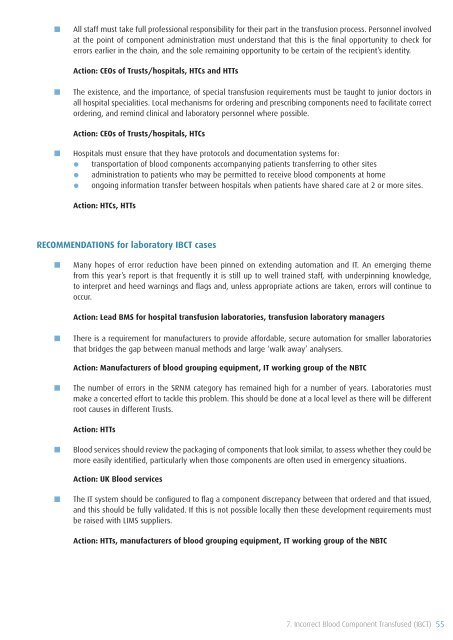SHOT Annual Report 2009 - Serious Hazards of Transfusion
SHOT Annual Report 2009 - Serious Hazards of Transfusion
SHOT Annual Report 2009 - Serious Hazards of Transfusion
You also want an ePaper? Increase the reach of your titles
YUMPU automatically turns print PDFs into web optimized ePapers that Google loves.
■■<br />
All staff must take full pr<strong>of</strong>essional responsibility for their part in the transfusion process. Personnel involved<br />
at the point <strong>of</strong> component administration must understand that this is the final opportunity to check for<br />
errors earlier in the chain, and the sole remaining opportunity to be certain <strong>of</strong> the recipient’s identity.<br />
Action: CEOs <strong>of</strong> Trusts/hospitals, HTCs and HTTs<br />
■■<br />
The existence, and the importance, <strong>of</strong> special transfusion requirements must be taught to junior doctors in<br />
all hospital specialities. Local mechanisms for ordering and prescribing components need to facilitate correct<br />
ordering, and remind clinical and laboratory personnel where possible.<br />
Action: CEOs <strong>of</strong> Trusts/hospitals, HTCs<br />
■■<br />
Hospitals must ensure that they have protocols and documentation systems for:<br />
transportation <strong>of</strong> blood components accompanying patients transferring to other sites<br />
administration to patients who may be permitted to receive blood components at home<br />
ongoing information transfer between hospitals when patients have shared care at 2 or more sites.<br />
Action: HTCs, HTTs<br />
RECOMMENDATIONS for laboratory IBCT cases<br />
■■<br />
Many hopes <strong>of</strong> error reduction have been pinned on extending automation and IT. An emerging theme<br />
from this year’s report is that frequently it is still up to well trained staff, with underpinning knowledge,<br />
to interpret and heed warnings and flags and, unless appropriate actions are taken, errors will continue to<br />
occur.<br />
Action: Lead BMS for hospital transfusion laboratories, transfusion laboratory managers<br />
■■<br />
There is a requirement for manufacturers to provide affordable, secure automation for smaller laboratories<br />
that bridges the gap between manual methods and large ‘walk away’ analysers.<br />
Action: Manufacturers <strong>of</strong> blood grouping equipment, IT working group <strong>of</strong> the NBTC<br />
■■<br />
The number <strong>of</strong> errors in the SRNM category has remained high for a number <strong>of</strong> years. Laboratories must<br />
make a concerted effort to tackle this problem. This should be done at a local level as there will be different<br />
root causes in different Trusts.<br />
Action: HTTs<br />
■■<br />
Blood services should review the packaging <strong>of</strong> components that look similar, to assess whether they could be<br />
more easily identified, particularly when those components are <strong>of</strong>ten used in emergency situations.<br />
Action: UK Blood services<br />
■■<br />
The IT system should be configured to flag a component discrepancy between that ordered and that issued,<br />
and this should be fully validated. If this is not possible locally then these development requirements must<br />
be raised with LIMS suppliers.<br />
Action: HTTs, manufacturers <strong>of</strong> blood grouping equipment, IT working group <strong>of</strong> the NBTC<br />
7. Incorrect Blood Component Transfused (IBCT) 55












